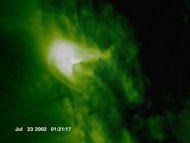RHESSI
Full Name: Reuven Ramaty High Energy Solar Spectroscope Imager
Phase: Operating
Launch Date: February 05, 2002
Mission Project Home Page: http://hessi.ssl.berkeley.edu/
Program(s): Explorers, Heliophysics Explorers
Researchers believe that much of the energy released during a flare is used to accelerate, to very high energies, electrons (emitting primarily X-rays) and protons and other ions (emitting primarily gamma rays). The new approach of the HESSI mission is to combine, for the first time, high-resolution imaging in hard X-rays and gamma rays with high-resolution spectroscopy, so that a detailed energy spectrum can be obtained at each point of the image. This new approach will enable researchers to find out where these particles are accelerated and to what energies. Such information will advance understanding of the fundamental high-energy processes at the core of the solar flare problem.
RHESSI Observes Emission from a Solar Flare
The solar flare at Active Region 10039 on July 23, 2002 exhibits many exceptional high-energy phenomena including the 2.223 MeV neutron capture line and the 511 keV electron-positron (antimatter) annihilation line. In the animation, the RHESSI low-energy channels (12-25 keV) are represented in red and appears predominantly in coronal loops. The high-energy flux appears as blue at the footpoints of the coronal loops. Violet is used to indicate the location and relative intensity of the 2.2MeV emission. The coronal loops glow brightly in TRACE 195 Angstrom band.
Credit NASA/Goddard Space Flight Center Scientific Visualization Studio
The primary scientific objective of RHESSI is to understand the following processes that take place in the magnetized plasmas of the solar atmosphere during a flare:
- impulsive energy release,
- particle acceleration, and
- particle and energy transport.
These high-energy processes play a major role at sites throughout the universe ranging from magnetospheres to active galaxies. Consequently, the importance of understanding these processes transcends the field of solar physics; it is one of the major goals of space physics and astrophysics. The high energy processes of interest include the following:
- rapid release of energy stored in unstable magnetic configurations, equally rapid conversion of this energy into the kinetic energy of hot plasma and accelerated particles (primarily electrons, protons and ions),
- transport of these particles through the solar atmosphere and into interplanetary space, and
- subsequent heating of the ambient solar atmosphere.
The acceleration of electrons is revealed by hard X-ray and gamma-ray bremsstrahlung while the acceleration of protons and ions is revealed by gamma-ray lines and continuum. The proximity of the Sun means, not only that these high-energy emissions are orders of magnitude more intense than from any other cosmic source, but also that they can be better resolved, both spatially and temporally.

